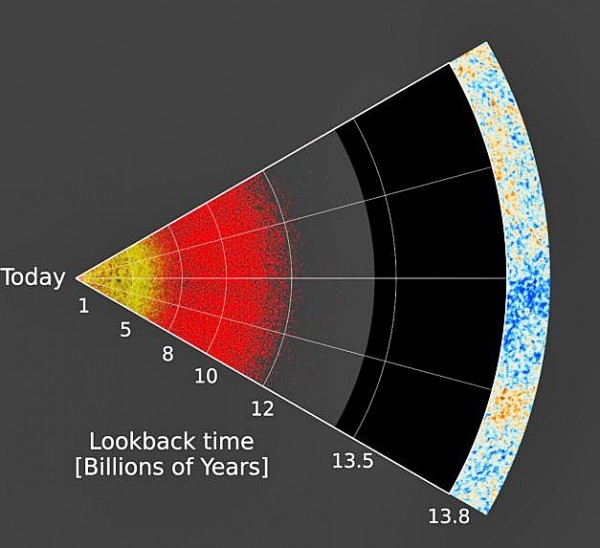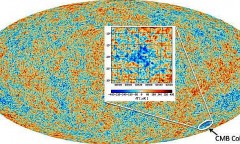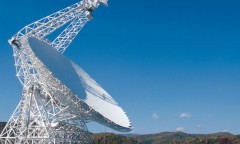By Arthur Dominic J. Villasanta , | May 26, 2017

A slice through largest-ever three-dimensional map of the Universe. Earth can be seen on the left, and distances to galaxies and quasars are labelled by the lookback time to the objects.
The largest ever 3D map of the Universe has been created by a team of astronomers working with the Sloan Digital Sky Survey (SDSS).
Astronomers say the new map is the first to exclusively use the positions of quasars to chart the significant structures of the Universe.
Like Us on Facebook
"Because quasars are so bright, we can see them all the way across the Universe," said study co-leader Ashley Ross, from Ohio State University. "That makes them the ideal objects to use to make the biggest map yet."
Quasars are large compacted masses surrounding enormous black holes at the center of distant galaxies. They discharge an incredible amount of energy in the form of visible light or infrared radiation.
Quasars go through periods of extreme brightness which can last anywhere from 10 to 100 million years.
SDSS is a major multi-filter imaging and spectroscopic redshift survey using a dedicated 2.5 meter wide-angle optical telescope at Apache Point Observatory in New Mexico. Data collection began in 1998, and the final imaging data release covers over 35 percent of the sky.
The new 3D map of massive galaxies and distant black holes will help astronomers explain the mysterious "dark matter" and "dark energy" scientists know makes up 96 percent of the Universe.
With such a map, scientists can retrace the history of the Universe over the last six billion years. With that history, they can get better estimates for how much of the Universe is made up of dark matter -- matter that we can't directly see because it doesn't emit or absorb light -- and dark energy, the even more mysterious force that drives the accelerating expansion of the Universe.
That map of the Universe is the centerpiece of DR9. It includes new spectra from 540,000 galaxies from when the Universe was half its present age.
Early last year, SDSS-III released the largest-ever image of the sky. With the new release of data, SDSS-III has begun to expand this image into a full three-dimensional map. Data Release 9 (DR9), posted online last week, makes available the first third of the galaxy map that this six-year project will create.
Begun in 2008, SDSS-III comprises four separate surveys, each conducted on the same 2.5 m telescope.
"What really makes me proud of this survey is our commitment to creating a legacy for the future," said Michael Blanton, a professor at New York University who led the team that prepared DR9.
"Our goal is to create a map of the Universe that will be used long after we are done, by future generations of astronomers, physicists and the general public."
Data Release 9 is the latest in a series of data releases stretching back to 2001. This release includes new data from the ongoing SDSS-III Baryon Oscillation Spectroscopic Survey (BOSS).
BOSS will eventually measure the positions of 1.5 million massive galaxies over the past six billion years of cosmic time, as well as 160,000 quasars (giant black holes actively feeding on stars and gas) from as long ago as 12 billion years in the past.
A spectrum is a measure of light from a galaxy at different wavelengths; from this information we can measure the distances to those galaxies. This distance information provides the third dimension in the DR9 map, providing a more detailed view of the structure of the Universe than has been measured before.
-
Use of Coronavirus Pandemic Drones Raises Privacy Concerns: Drones Spread Fear, Local Officials Say

-
Coronavirus Hampers The Delivery Of Lockheed Martin F-35 Stealth Fighters For 2020

-
Instagram Speeds Up Plans to Add Account Memorialization Feature Due to COVID-19 Deaths

-
NASA: Perseverance Plans to Bring 'Mars Rock' to Earth in 2031

-
600 Dead And 3,000 In The Hospital as Iranians Believed Drinking High-Concentrations of Alcohol Can Cure The Coronavirus

-
600 Dead And 3,000 In The Hospital as Iranians Believed Drinking High-Concentrations of Alcohol Can Cure The Coronavirus

-
COVID-19: Doctors, Nurses Use Virtual Reality to Learn New Skills in Treating Coronavirus Patients









